Collections – Diecast planes – Part 2
More examples of diecast aircraft with Hatfield links
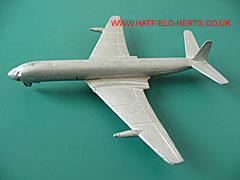
Lone Star 250/2 Comet 4. The Lone Star Comet represents a Hatfield double as both the Comet was built here and Lone Star had its headquarters in the town.
Please click here to visit the Claims to Fame – Toys page
The first Comet 4, G-APDA (06401), made its first flight at Hatfield on 27 April 1958. Probably the most noticeable difference between the early Comets and the Mk.4 are the wing pinion fuel tanks (although this feature was first introduced in the Mk.3). Lone Star's 250 series was named after the scale 1:250, and the Aircraft of the World range included the Bristol Britannia, Boeing 707, Sud-Est Caravelle and Vickers 801 Viscount. They were issued with water-slide transfers (like those used in plastic model kits). The Comet 4 had the made up registration G-BOAC. The Lone Star Comet can also claim an educational role as the underside of the wing is embossed with technical specifications – like the aircraft weight, range, speed, dimensions and type of engines.
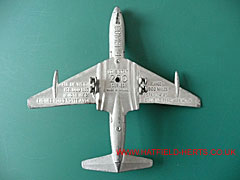
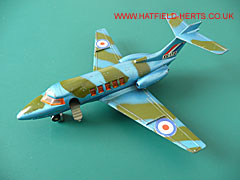
Dinky Toys Hawker Siddeley 125 – bearing RAF registration XG172. Originally designed as a business jet, it made its first flight from Hatfield on 13 August 1962. Although de Havillands was by now taken over by Hawker Siddeley they used the DH design numbers for both the HS.121 Trident and the HS.125. In RAF service it was called the Dominie – the second de Havilland aircraft to have this service name (the first being the DH.89 Dragon Rapide). This diecast has retractable undercarriage and a pull down access steps. The registration is false (XG172 is thought to belong to a Hawker Hunter, which is preserved at the City of Norwich Air Museum – but with the markings of XG168). Released in the Seventies as part of a blisterpack range. However, this example is something of a mystery – embossed under the left wing is 'Hawker Siddeley 125' with the number '723' beneath. According to Dinky's 1973 catalogue, No.723 was the Hawker Siddeley Executive Jet, while No.728 was the RAF Dominie. It's possible that due to a shortage or mistake a 723 wing and body (or a 723 wing and a 728 fuselage) was painted in the 728 scheme. If this was a rare occurrence then this diecast would be worth more to collectors. Alternatively, this could be the work of a restorer who has used salvaged parts and joined a 723 wing with a 728 body. In which case it's relatively worthless as a collector's item.
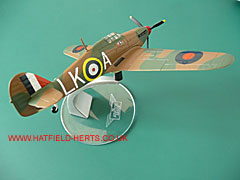
Corgi The Aviation Archive collection, Hawker Hurricane Mk.I, P2798 (Ref.49014), part of the Battle of Britain 1940-2000 range. This 1:72 scale diecast, modelling a plane flown by fighter ace Wing Commander Ian Gleed, is No.2116 (out of 5,000), and included a replica copy of the original Hawker Hurricane pilot's notes. Any budding collector needs to make sure that they also get additional items, like the pilot's notes and limited edition certificate (or get a suitable price reduction). This is especially true if such extras are mentioned on the box or elsewhere in the packaging as it will affect the item's value.
Please click here to see the Wg Cmdr Ian Gleed feature
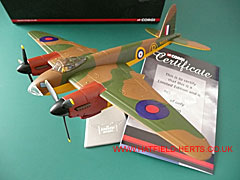
Corgi The Aviation Archive collection DH.98 Mosquito prototype W4050 (Ref. AA32817), part of the 'Survivors' range. The DH.98 Mosquito prototype W4050 was developed and built at Salisbury Hall, London Colney. Transported by road, it made its first flight at Hatfield on 25 November 1940. The aircraft is preserved at the de Havilland Aircraft Heritage Museum bordering Salisbury Hall. The 1:72 scale diecast shown here is No.0481 out of a limited edition of 1,200.
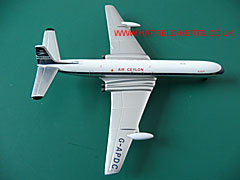
Aero Classics DH.106 Comet 4C – bearing registration G-APDC, and in a joint BOAC and Air Ceylon livery. The aircraft, serial number 6404, was built at Hatfield and delivered to BOAC on 30 September 1958. The joint BOAC and Air Ceylon (original state carrier for Ceylon, now Sri Lanka) markings are because Air Ceylon leased a number of BOAC Comets in the 1960s. This 1:400 scale diecast example is a 'Series 1, limited Edition, Certified Collection' according to the box. However, it was bought second hand and does not have any markings or paperwork to prove that it is a limited edition (other than the box inscription, which does not give the size of the release). This lack of provenance / documentation reduces its value as a collectors item (and it may breach the Trade Descriptions Act if it were to be offered for sale as a limited edition in this condition).
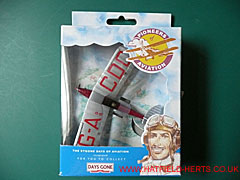
Lledo Pioneers of Aviation (Dg117000) DH.82A Tiger Moth – bearing registration G-ACDC, and in the red and silver livery of The de Havilland School of Flying. Released in 2001 as a replica of the oldest flying Tiger Moth (constructor's number 3177). However, after a long restoration G-ACDA (constructor's number 3175) returned to the skies in 2008. Both G-ACDA and G-ACDC were built at Stag Lane but based at Hatfield for the first part of their 'lives' and used to train budding pilots. A claim for the oldest flying Tiger Moth is also made for one based in Sweden, SE-ADF, which may be one of the pre-production aircraft sold overseas. However, purists may argue that this was a DH.60T Tiger Moth. The first aircraft to bear the DH.82 designation (and according to at least one source, the first to be called a Tiger Moth) flew on 26 October 1931 (the identity change was due to an increased dihedral on the lower wings – basically an increase in the upward angle of the wings when viewed head on – and an increase in the sweepback of the wings). The introduction of the Gipsy Major 130hp engine led to further modifications and the DH.82A designation.
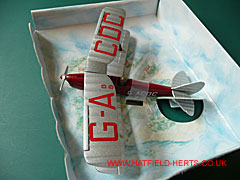
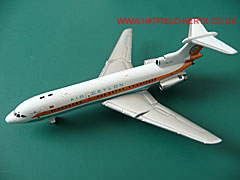
GeminiJets Air Ceylon HS.121 Trident 1E (GJACE773) – bearing registration 4R-ACN. Released in 2008 in 1:400 scale. The aircraft depicted originally had the UK registration G-AVYA (constructor's number 2135). Registration papers suggest ownership transferred in November 1968 but it appears the aircraft may have been refitted as it appears to have joined the fleet around September the following year. Air Ceylon, the state airline of Ceylon (now Sri Lanka), was formed in 1948, and ceased operations on 31 March 1978. 4R-ACN was withdrawn from service that year, and broken up in 1998. GeminiJets is an American company based in Las Vegas, and has been trading at least since 1998.
Back to: Hobbies and Collections